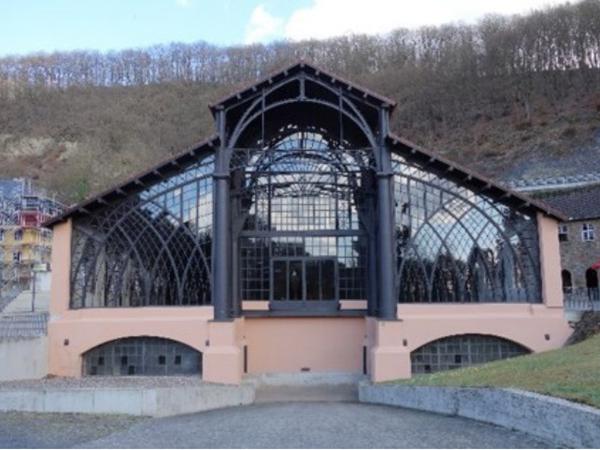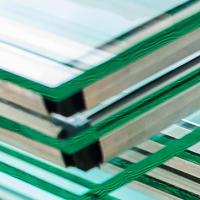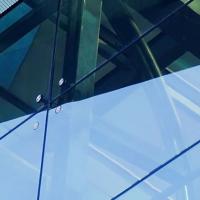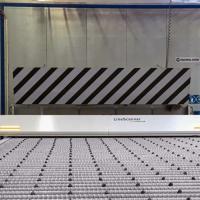This paper was first presented at GPD 2023.
Link to the full GPD 2023 conference book: https://www.gpd.fi/GPD2023_proceedings_book/
Authors:
- Franziska Rehde, Institute of Building Construction, Technische Universität Dresden, August-Bebel-Straße 30, 01219 Dresden, Germany
- Alina Gutjahr, Institute of Building Construction, Technische Universität Dresden, August-Bebel-Straße 30, 01219 Dresden, Germany
- Michael Engelmann, Institute of Building Construction, Technische Universität Dresden, August-Bebel-Straße 30, 01219 Dresden, Germany
Abstract
Glass surfaces are characteristic for the façade appearance and contribute significantly to the authenticity of architectural monuments. The material glass is considered an important testimony of its time. Depending on the manufacturing process, it differs both in surface and in material composition. The period of high modernism (ca. 1880-1970) overlapped with the technical developments of the industrial revolution, which led from manual to industrial production. The further development of manufacturing processes as well as the dimensions and qualities of glass thus shaped the development of glass constructions, which had to become increasingly slender over time in order to ensure a high degree of transparency.
Nowadays, historic windows are often replaced by new glazings made of float glass, which can cause the authentic character of buildings to be lost. A research team from the Technische Universität Dresden and the University of Bamberg are examining glass and its construction in detail in the period from around 1880 to around 1970. They define the living character of industrially manufactured glass from the time before the introduction of float glass as an authentic and style-forming feature of the era.
The present work presents the investigation of historical glass and glass constructions in a suburb of Dresden. It was determined how much the historic glass is currently still present in the study area. From the results and the evaluation, the importance of historic glass constructions is deduced for engineers, planners and monument conservators, who can contribute a great deal to the preservation of historic glazing.
1. Introduction
1.1 Historic glass in buildings
Until the time of the Industrial Revolution, window glazings were subject to continuity over many centuries and hardly underwent any further development. The windows and their constructions only differed in the structure and size of the frames, the fittings or different colour details. These were adapted and executed according to the taste of the time and the architecture. Window constructions thus document the technical, but also the design and craftsmanship possibilities of the respective time of origin.
The glass itself is thus a testimony to the materiality of its time. In terms of production technology, both the surfaces of the various manufacturing processes and the material composition itself differ. Nowadays, historical glasspanes and windows are often replaced. The reason for replacement is that glass is a ubiquitous product that is available in abundance and at low cost. Currently, there are no principals for indentifying glass from the industrialisation period and assign it to the different manufacturing techniques used in the past. Glass from the industrialisation period has an undulating structure and optical disturbances such as bubbles. However, nowadays this is interpreted more as a defect than as a testimony to the technical progress of the time. Historical glasspanes and windows are often replaced by new float glass with plastic frames. However, this leads to a loss of authenticity of historic buildings and inevitably to a destruction of testimonies to the history of building technology (see Figure 1).

Today's flat glass consists of a basic glass, produced in the float glass process. But before the introduction of the float process in 1962 for the production of flat glass in Cologne - Porz, Germany, glass production was far more differentiated. Thus, over the past 200 years, a total of five manufacturing processes have developed that significantly influenced glass production and glass quality. There were special types of glass for the various applications in buildings, each of them had special properties and also documented the former craftsmanship and the state of the art at that time. [1]
These aspects of design and architectural history contribute to the interest in preserving historic glass constructions. However, in practice contrary developments are observed. In the course of the energy and oil crisis in 1973 and the accompanying discussions on climate change and the first heat insulation ordinance in 1977, an estimated 60 % of historic glass constructions in Germany were replaced. [2] At the beginning of the 1990s, plastic windows spread rapidly on the German window market. In justified individual cases, these were also allowed to replace historic windows in cultural monuments. [3] Although the law on the protection of historical monuments, for example in Saxony. Baron [4] requires the preservation of historical building fabric, not all windows can be preserved.
Moreover, not every historic building is a cultural monument and is thus solely subject to the owner's freedom of decision and design. According to the German Window + Facade Association (VFF), around 51 million windows, countersash or composite windows still exist as single-glazing. Most likely, this number represents the share that was executed with historical glass and older materials. The window constructions mentioned are further developments of single glazing due to the significantly higher thermal insulation. This thermal insulation and the resulting energy efficiency have led to the replacement of these historic buildings since the mid-1970s due to the ever more stringent normative limits. This replacement process, which has already taken place, is clearly illustrated by the small number of historic windows within the total stock of existing window units in Germany, which is estimates to a total of 610 million.
1.2 Reasons for replacement
The reasons for replacement of historic windows can be returned to several factors. With the introduction of larger pane sizes and the associated possibility of larger undivided wings, many countersash windows were replaced by composite windows, which were are undivided across the entire window opening. Some of these were inserted into the historic fittings, which caused these wings to sag, the old fittings were damaged and the windows were replaced again. [5] After the first oil crisis in 1973, the historic single-glazed wooden windows or countersash windows were replaced by new windows with insulating glass units. And low thermal insulation of the exterior walls more mould damage occurred after the replacement.
Furthermore, with the replacement of the glasspane, it was no longer the coldest point in the room, but rather lintels, corners of the room or exterior walls, which led to increased mould problems. Hence, many windows had to be replaced again. [6] In addition, for many years it was a common application that laminated and insulated glass windows that replaced building-period constructions were not considered worthy of preservation and could be replaced. Many of the modern windows were probably replaced in the 1990s. Due to ownership change after the end of the GDR. The new owners were probably anxious to modernise their flats and replace the old windows with new insulating glass units.
Pictures from the 1990s showing the buildings with old window stock, it can often be seen that different constructions were installed in the building. The economy of scarcity in the GDR presumably meant that there were not enough funds to maintain windows or to replace them uniformly. It is possible that the existing nonuniform window stock was to be changed into a uniform stock by modern windows and glass when the financial means were available after reunification of Germany. Furthermore, the research by Klos [7] shows that there was a change in the window market in the 1990s. Since 1989, there has been a sharp increase in the production of plastic windows, while windows made of wood and aluminium have been produced in the same quantities as in previous years.
Replacing windows is therefore more a matter of improving the use by the owner than of preserving the historic fabric of the building and the appearance of the façade. In this case, it requires the intervention of the responsible state office for the Preservation of Historical Monuments, which, however, can only veto such measures in the case of buildings with listed status. The preservation of windows, general building components and structures is an important sustainable and environmentally friendly step.
In order to understand the need to preserve historic stocks and how the preservation of historic glasspanes and especially the construction of these windows has fared in recent years, the stock of these are recorded. The subject of the study was the urban area of Trachau in the northwest of Dresden. The buildings and windows recorded there were documented in a catalogue and in the QGIS database, and the results of the inventory were evaluated. QGIS (formerly QuantumGIS) is a free geoinformation system software for viewing, editing, analysing and recording spatial data.
2. Historical glass
2.1 Glass manufacturing processes
For the investigation and evaluation of historical flat glass products and the window construction as found in Trachau, it was essential to first recognise them and afterwards to distinguish whether they were a) of the construction period or b) replaced but old or c) replaced and new. The production of flat glass at the time of the High Modernism was characterised by numerous innovations in the manufacturing processes and a transition from manual to industrial production of the glass.
There are four main different methods of glass production: casting, pressing, blowing and drawing. One of the oldest methods is the cast glass process (17th century) for the production of mirrors. It was considered an important strand for the development of float glass. Parallel to this, the way of drawing processes developed. This way developed from the moon glass process (centrifugal process) and cylinder blowing process, see Figure 2.
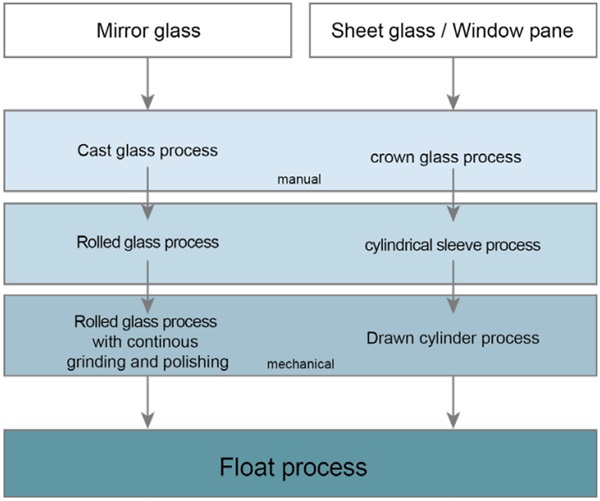
Table glass was produced exclusively by the cylindric blowing process until the introduction of the first table drawing process in Germany. Most of the processes were invented bit earlier in other countries. In 1924, the first glassworks in Germany began producing drawn glass using the Fourcault process. By the end of 1929, the production of hand-blown flat glass had been completely vanished in Germany. [8] Following, sheet glass was produced by the cylindric blowing process until 1924. In the period from 1924 to 1929 sheet glass products were mouth-drawn and machine-drawn. From 1930 on, sheet glass products were produced by the drawing process only, see Figure 3.
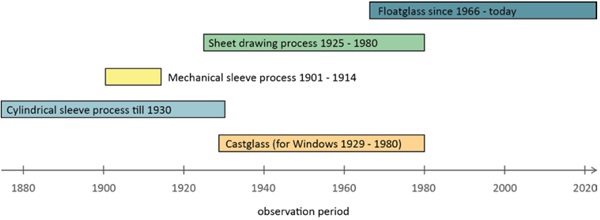
In Germany, all three drawing processes were represented: the Fourcault, the Pittsburgh and the Libbey-Owens processes. The majority of glass factories produced using the Fourcault process. In the surrounding of the investigated area (Trachau), many factories produced in Fourcault. From 1933 onwards, flat glass was probably only used from the Fourcault process in Saxony, especially in Dresden.
2.2 Historic window recognition
Figure 4 shows the differences between a no-window pane (a), the blowing process and the drawing process. With hand-blown glass (b), the wavy stripes are clearly visible. Originally straight lines are shown wavy through the glass. With drawn glass (c) the waviness relativises and is hardly perceptible, the lines remain straight. Thus, one might think that this could be a float glass pane. The difference is that a pane of glass using the Fourcault process is much less reflective than a pane using the float process.

2.3 Detection of replaced windows
Historic house fronts are often based on old natural measurements such as ell or foot. Thus, a unity in design and a harmonious image is achieved. For this reason, the installation of new windows with different dimensions can appear disharmonious. [5] This takes place when a window opening is enlarged or the number of sashes in a window is changed. When a triple-paned window is reduced to a double -pane one, the window sashes become wider. This is particularly noticeable when the window sash width of the other windows at the front of the house is maintained.
Another distinguishing feature of a replaced modern window is the change in material.
The use of modern window profiles also raises the problem that they are designed for large window sashes of the modern era. This results in large window profiles and frames. If the division of a historical window is reproduced with modern window profiles, the glass areas are significantly reduced. [9] Figure 5 shows two plastic windows in an old building. The window on the left demonstrates a window in which the forend of the once three-light window is only applied to the window pane as a thin profile. The right image demonstrates how wide the surrounding window frame and the stop of both sashes are compared to historic window construction.
Furthermore, skylights in historical gallows windows were not permanently glazed. [9] In addition, the historical window division is often only present as an ornament in modern windows. [10] The design of the glazing bars also allows conclusions to be drawn about the age of the window. In particular, glazing bars bonded onto the insulating glazing or lying inside the insulating indicate modern constructions. [11] Insulating glass units are made of float glass and are installed in modern window constructions. Flat glass has plane-parallel surfaces, which leads to distortion-free transparency and high reflectivity. [12]
However, Mirror glass has not been integrated into insulating glass or developed further to insulating glass. Moreover, this insulating glass shown in Figure 5 can be recognised by the metal spacers.
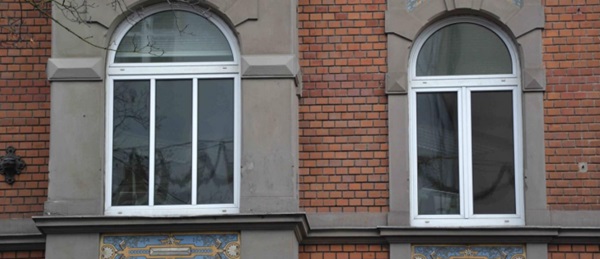
3. Inventory in the study area
The district of Trachau is located in the urban area of Dresden, see Figure 6. Due to the size of the district, the investigated area was divided into Construction periods. The aim of the investigation is to determine the current glass type in buildings that were once almost certainly equipped with those from the high modern era.
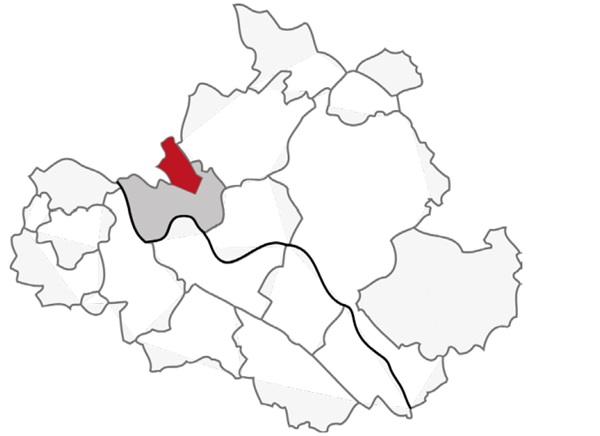
After research and visual inspection, the area is further limited to a part in the south-east of Trachau. The aim was to be able to estimate possible glass and constructions to be expected for the subsequent inventory survey in Trachau. In the south-east of the survey area, a large number of historic windows were to be expected after a walk-through. Due to the aforementioned significant change in the manufacturing methods of glass panes in the 1920s, it was of high interest to look specifically at the buildings from this period in order to obtain the highest possible density of different types of drawn glass, see Figure 7. The analysis of the district catalogue revealed that approximately 80 % of the buildings were built before 1945.
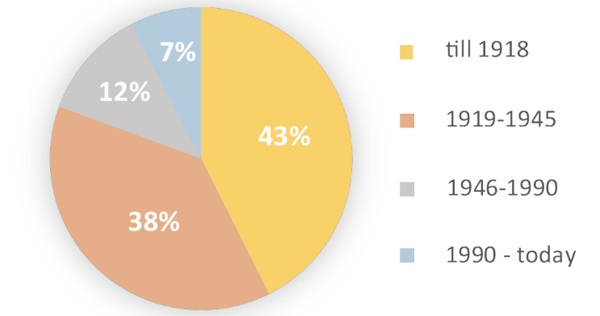
A total of 45 buildings on “Wilder Mann Straße” were examined for possible window constructions and their optical features in the style of high modernism and measured manually by hand, see Figure 8. For each building, the glass, the glass construction, the frames, the material and geometry were documented in detail with the help of a recording sheet. A total of 2178 windows were recorded, documented and evaluated.
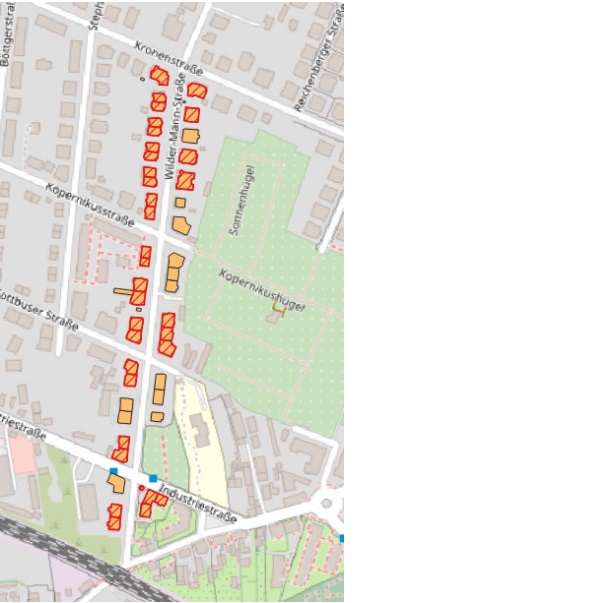
4. Evaluation
4.1 Method
The evaluation of the results took place in 2 steps. First, quantitative statements were made about certain properties per building and in a second step, a quantitative evaluation of the window stock per building was carried out. A total of 45 buildings in the study area were examined. Of the total of 2178 windows recorded for all 45 buildings, only 117 still date from the period of high modernism. Of these, 83 windows were presumably built when the building was constructed and 34 were installed after the construction period but still during the High Modernism period. This can be concluded with the help of the evaluation of the window construction recorded in the first step. Hence, 91.6% of the window constructions have been replaced since the introduction of the float glass method.
4.2 Results
Of the 117 historic glass constructions , 34 windows are glazed with drawn glass, 79 windows are glazed with cylinder blowing and 4 windows are glazed with mirror glass. On found photos from the 1990s, historic windows can still be seen on some buildings. Hence, it was assumed that most of the constructions have probably only been replaced since the end of the 1990s.
The following Table 1 lists the buildings with construction-period and historic windows . 37 Buildings out of 45 have a 0.0 % stock of glasspanes and window constructions from the period of high modernism.
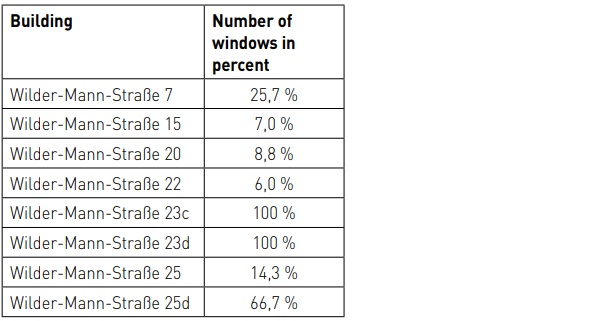
5. Summary and Outlook
Glazing and glass constructions are among the style-defining elements of a façade in secular buildings of the high modern era (appx. 1880 - 1970). Although these contribute so significantly to the appearance and thus to the authenticity of a façade, today the original building stock is often no longer preserved. This is not only accompanied by a loss of the aesthetic impression of the façade, but with the replacement of the glazing, original materiality and technical history are irretrievably lost. The results of the investigation of the Trachau district in Dresden, Germany show the little original building fabric is still present in the existing buildings.
Of the total of 2178 windows identified, 2061 windows had been replaced and thus only 117 windows of the historic glazing were still preserved. In an investigation of a street in Bamberg, Germany from 1586 examined windows 1088 had been replaced. These examples clarify the loss of periodtypical glazing of high modernity. In addition, a manual recording of the glass and glass constructions is very time-consuming. To reduce the manual effort, it is recommenden to develop automized methodes, e.g. by using capturing the current stock using modile cameras or analyzing exising data.
Nevertheless, the reappraisal of the historical application of flat glass in architecture and the building industry is an important and valuable point in order to preserve the understanding and constructions of times long past for our future generations. This is the only way that restoration work can be carried out in a more appropriate and monument-friendly manner in the future, where the focus is not purely on energy efficiency and aesthetics. Most reasonable question is: can the important authenticity also be achieved with new glasspanes and new window constructions?
6. Acknowledgements
In the current DFG-funded project "Materiality and Authenticity of Glasses and Glass Constructions of High Modernity", questions about historical glasses and glass constructions are being investigated and discussed. The results obtained are an important part of the reappraisal of the history of technology.
Figure 1 both Photos: © Dr. Karn
Figure 2 own presentation, according to Glocker 2017, S. 13.
Figure 3 own presentation
Figure 4 Dralle, 1931, S. 770
Figure 5 © Koch-Kinne
Figure 6 own presentation
Figure 7 Kommunale Statistikstelle, 2020
Figure 8 Screenshot QGIS, Alina Gutjahr, 2022
7. References
[1] Schulze, Jörg (2004). Bewahrung historischer Fenster aus technischen Gründen. In PaX HolzFenster GmbH Bad Lausick (Hrsg.), Fenster im Baudenkmal. PaXclassic Fachtagung - Fenster im Baudenkmal zur "denkmal 2002": Tagungsbeiträge vom 30. und 31. Oktober 2002. eine Initiative der PaX Holz-Fenster GmbH (S. 28–37), Lukas Verlag.
[2] Gerner, Manfred & Gärtner, Dieter (1996). Historische Fenster: Entwicklung, Technik, Denkmalpflege, Deutsche Verlags-Anstalt; Julius Hoffman Verlag.
[3] Behrens, Helmut (2004). Im Namen des Volkes: Gerichtsurteile zum Thema "Fenster im Baudenkmal". In PaX Holz-Fenster GmbH Bad Lausick (Hrsg.), Fenster im Baudenkmal. PaXclassic Fachtagung - Fenster im Baudenkmal zur "denkmal 2002": Tagungsbeiträge vom 30. und 31. Oktober 2002. eine Initiative der PaX Holz-Fenster GmbH (S. 7–18), Lukas Verlag.
[4] Baron, Norbert (Hrsg.) (1999). Sanierungstipps: Bd. 1. Kastenfenster: Erhalt und Aufarbeitung von historischen Kastenfenstern.
[5] Heinrich, Werner (1996). Die Bedeutung des Fensters aus denkmlapflegerischer Sicht. In Staatsministerium des Innern (Hrsg.), Schriftenreihe für Baukultur, Architektur, Denkmalpflege: Bd. 1. Das Fenster im Profanbau in Sachsen: Baukonstruktive Blätter (S. 6–10), Freistaat Sachsen.
[6] Eicke-Hennig, Werner (2012). Energieeinsparung an Fenstern und Außentüren: Wissenswertes über die Erneuerung und Sanierung von Fenstern und Türen. Energiesparinformationen unter https://www.iwu.de/fileadmin/user_upload/dateien/energie/espi/espi1.pdf (zuletzt abgerufen am 04.09.2022).
[7] Klos, Hermann (2012). Fenster aus Eisen, Stahl und Aluminium: Äußerst langlebig und dennoch im Bestand gefährdet. Denkmalpflege in BadenWürttemberg, 41(1/2012), S. 28–35 unter https://journals.ub.uni-heidelberg.de/index.php/nbdpfbw/article/view/12282 (zuletzt abgerufen am 05.03.2023).
[8] Spoerer, Mark (1993). Der Konzentrationsprozeß in der deutschen Tafelglasindustrie 1925 bis 1932: Eine Fallstudie über den Einfluß des technischen Fortschritts auf Marktstruktur und Marktergebnis. Zeitschrift für Unternehmensgeschichte, 38, S. 73–113.
[9] Wilkening, Frank (2004). Restaurierung im Bestand und Ergänzung durch klassische Innenvorsatzfenster: Erhaltung historischer Fenster - Steigerung des Denkmalwertes. In PaX HolzFenster GmbH Bad Lausick (Hrsg.), Fenster im Baudenkmal. PaXclassic Fachtagung - Fenster im Baudenkmal zur "denkmal 2002": Tagungsbeiträge vom 30. und 31. Oktober 2002. eine Initiative der PaX Holz-Fenster GmbH (S. 19–27), Lukas Verlag.
[10] Noky, Thomas (1996a). Die Entwicklung des Fensters in Sachsen. In Staatsministerium des Innern (Hrsg.), Schriftenreihe für Baukultur, Architektur, Denkmalpflege: Bd. 1. Das Fenster im Profanbau in Sachsen: Baukonstruktive Blätter (S. 39–44), Freistaat Sachsen.
[11] Demel, Manuel & Benitz-Wildenburg, Jürgen (2014). Energetische Sanierung von denkmalsgeschützen Fenstern und Fassaden: Kompromisse zwischen Bautechnik und Denkmalschutz, ift - Institut für Fenstertechnik Rosenheim unter https://www.ift-rosenheim.de/documents/10180/671018/FA_ift1409_Demel_Benitz.pdf/da4ff291-a2a5-42f7-95c7-b49676486bdf (zuletzt abgerufen am 22.04.2023).
[12] Ebinger, Christian (2020). Floatglas, Schweizer Baumuster-Centrale Zürich unter https://materialarchiv.ch/de/ma:material_287#ma:material_287-ma:has_sources_information (zuletzt abgerufen am 27.10.2022).

